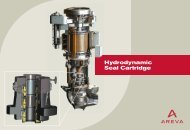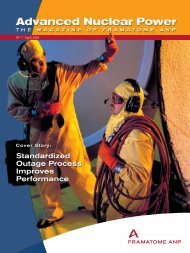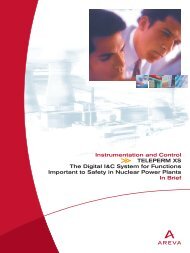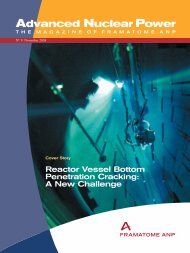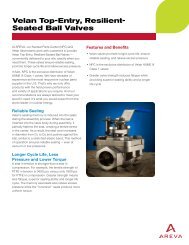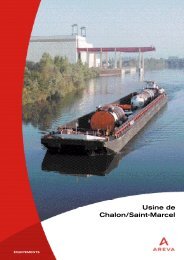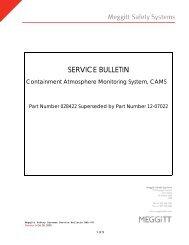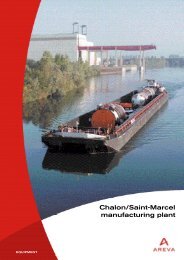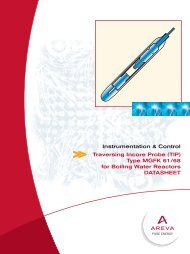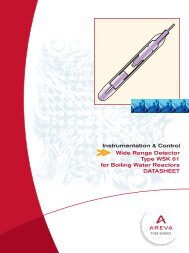EPR – Areva brochure
EPR – Areva brochure
EPR – Areva brochure
You also want an ePaper? Increase the reach of your titles
YUMPU automatically turns print PDFs into web optimized ePapers that Google loves.
■ <strong>EPR</strong> NUCLEAR ISLANDReactor InternalsThe Reactor Pressure Vessel Internals (RPVI) support the fuelassemblies and maintain their orientation and position within thecore, to ensure core reactivity control by the control assemblies andcore cooling by the primary coolant in any circumstances, includingpostulated accident circumstances.The RPVI allow insertion and positioning of the in-core instrumentationas well as protection against flow-induced vibrations during reactoroperation.The internals also contribute to the integrity of the second of thethree barriers against radioactive releases by protecting the ReactorPressure Vessel (RPV) against fast neutron fluence-inducedembrittlement.The internals accommodate the capsules containing samples of theRPV material which are irradiated then examined in the framework ofthe RPV material surveillance program.The RPVI are removed partially from the RPV to allow fuel assemblyloading/unloading, or are totally removed for complete access to theRPV inner wall for in-service inspection.The main parts of the RPVIUpper internalsThe upper internals house the Rod Cluster Control Assembly(RCCA) guides. The RCCA guide tube housings and columns areconnected to an RCCA guide support plate and an upper core plate.In operation, the upper internals maintain axially the fuel assembliesin their correct position.Core barrel assembly and lower internalsThe core barrel flange sits on a ledge machined from the RPV flangeand is preloaded axially by a large Belleville type spring. The fuelassemblies sit directly on a perforated plate, the core support plate.This plate is machined from a forging of stainless steel and weldedto the core barrel. Each fuel assembly is positioned by two pins180° apart.Heavy reflectorTo reduce neutron leakages and flatten the power distribution, thespace between the polygonal core and the cylindrical core barrel isfilled with a heavy neutron reflector. The heavy reflector is astainless steel structure, surrounding the core, made of rings piledup one on top of the other. The rings are keyed together and axiallyrestrained by tie rods bolted to the core support plate. The heatgenerated inside the steel structure by absorption of gamma radiationis removed by the primary coolant, through holes and gaps providedin the reflector structure.MaterialsMost of the internals are made of low Carbon Chromium-Nickelstainless steel. The various connectors, such as bolts, pins, tie rods,etc., are made of cold-worked Chromium-Nickel-Molybdenumstainless steel. At some locations, hard-facing materials are used toprevent fretting wear. To contribute to the radiation source termreduction, stainless steels are specified with a very low Cobaltresidual content and the use of Stellite hard-facing is reduced asmuch as possible.Heavy reflectorThe heavy reflector is an innovative feature with significantbenefits:† By reducing the flux of neutrons escaping from the core,the nuclear fuel is better utilized (more neutrons areavailable to take part in the chain reaction process),thereby making it possible to decrease the fuel cyclecost by reducing the fuel enrichment necessary to reacha given burnup, or to increase burnup with a givenenrichment.† By reducing the neutron leakages from the core, theReactor Pressure Vessel is protected against fastneutron fluence-induced aging and embrittlement,helping to ensure the 60-year design life of the <strong>EPR</strong>.† The reactor also provides advances in terms ofmechanical behavior of the internal structuresurrounding the core:• a smooth stress distribution inside the structure, due toan efficient inside cooling of the reflector, limiting loadsand avoiding deformation,• no discontinuities, like welds or bolts, in the mostirradiated areas,• a large decrease of depressurization loads to take intoaccount in case of assumed loss of coolant accident,because there is no significant quantity of watertrapped in the structure around the core.CHARACTERISTICSDATAReactor pressure vesselDesign pressure176 barDesign temperature 351 °CLife time (load factor 0.9)60 yrsInside diameter (under cladding)4,885 mmWall thickness (under cladding)250 mmBottom wall thickness145 mmHeight with closure head12,708 mmBase material 16 MND 5Cladding material Stainless steel (Cobalt 0.06%)Mass with closure head526 tEnd of life fluence level (E 1 MeV) IN-OUTfuel management scheme with UO 2 1 x 10 19 n/cm 2Base material final RT NDT(final ductile-brittle transition temperature) 30 °CClosure headWall thickness230 mmNumber of penetrations for:• Control rod mechanisms 89• Dome temperature measurement 1• Instrumentation 16• Coolant level measurement 4Base material 16 MND 5Cladding material Stainless steel (Cobalt 0.06%)Upper internalsUpper support plate thickness350 mmUpper core plate thickness60 mmMain material Z3 CN 18<strong>–</strong>10/Z2 CN 19<strong>–</strong>10Lower internalsLower support plate thickness415 mmLower internals parts material Z3 CN 18<strong>–</strong>10/Z2 CN 19<strong>–</strong>10Neutron heavy reflectorMaterial Z2 CN 19<strong>–</strong>10Mass90 t† The design of the <strong>EPR</strong> reactor pressurevessel internals is based on the N4 andKONVOI proven designs.† The heavy neutron reflector bringsan enhanced fuel utilization and protectsthe reactor pressure vessel against agingand embrittlement.† A low Cobalt residual content of thestainless steels is specified and the useof Stellite hard-facing is optimized soas to reduce radiation source term.Chooz B1, France (N4, 1,500 MWe) upper internals.24 II 25



